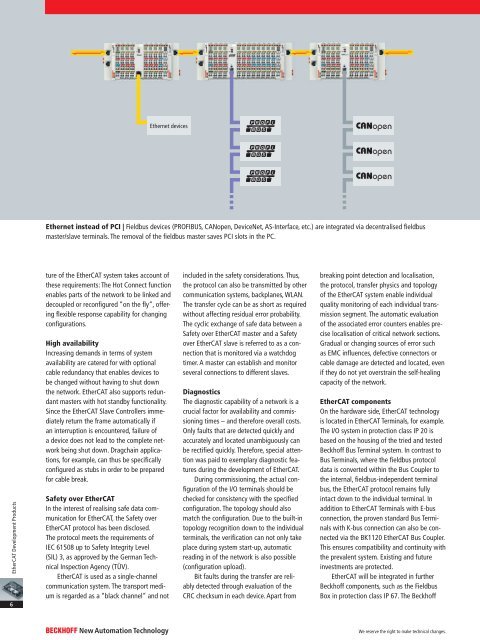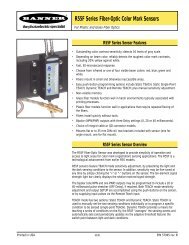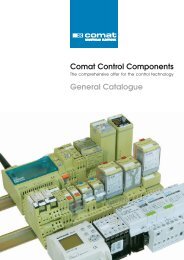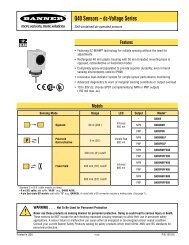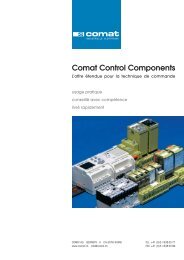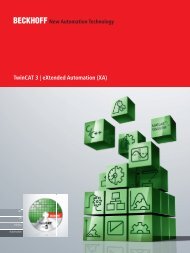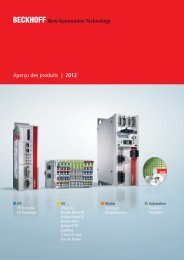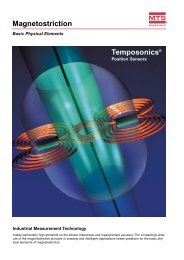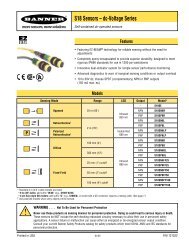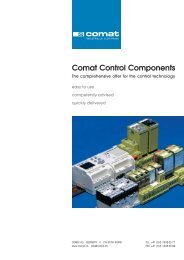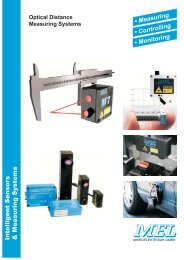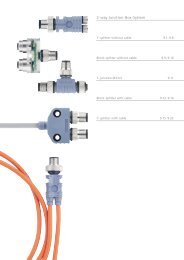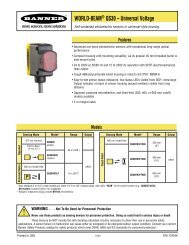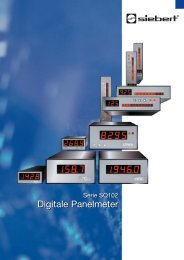Download - Multiprox
Download - Multiprox
Download - Multiprox
You also want an ePaper? Increase the reach of your titles
YUMPU automatically turns print PDFs into web optimized ePapers that Google loves.
Ethernet devices<br />
Ethernet instead of PCI | Fieldbus devices (PROFIBUS, CANopen, DeviceNet, AS-Interface, etc.) are integrated via decentralised fieldbus<br />
master/slave terminals. The removal of the fieldbus master saves PCI slots in the PC.<br />
EtherCAT Development Products<br />
6<br />
ture of the EtherCAT system takes account of<br />
these requirements: The Hot Connect function<br />
enables parts of the network to be linked and<br />
decoupled or reconfigured “on the fly“, offering<br />
flexible response capability for changing<br />
configurations.<br />
High availability<br />
Increasing demands in terms of system<br />
availability are catered for with optional<br />
cable redundancy that enables devices to<br />
be changed without having to shut down<br />
the network. EtherCAT also supports redundant<br />
masters with hot standby functionality.<br />
Since the EtherCAT Slave Controllers immediately<br />
return the frame automatically if<br />
an interruption is encountered, failure of<br />
a device does not lead to the complete network<br />
being shut down. Dragchain applications,<br />
for example, can thus be specifically<br />
configured as stubs in order to be prepared<br />
for cable break.<br />
Safety over EtherCAT<br />
In the interest of realising safe data communication<br />
for EtherCAT, the Safety over<br />
EtherCAT protocol has been disclosed.<br />
The protocol meets the requirements of<br />
IEC 61508 up to Safety Integrity Level<br />
(SIL) 3, as approved by the German Technical<br />
Inspection Agency (TÜV).<br />
EtherCAT is used as a single-channel<br />
communication system. The transport medium<br />
is regarded as a “black channel” and not<br />
included in the safety considerations. Thus,<br />
the protocol can also be transmitted by other<br />
communication systems, backplanes, WLAN.<br />
The transfer cycle can be as short as required<br />
without affecting residual error probability.<br />
The cyclic exchange of safe data between a<br />
Safety over EtherCAT master and a Safety<br />
over EtherCAT slave is referred to as a connection<br />
that is monitored via a watchdog<br />
timer. A master can establish and monitor<br />
several connections to different slaves.<br />
Diagnostics<br />
The diagnostic capability of a network is a<br />
crucial factor for availability and commissioning<br />
times – and therefore overall costs.<br />
Only faults that are detected quickly and<br />
accurately and located unambiguously can<br />
be rectified quickly. Therefore, special attention<br />
was paid to exemplary diagnostic features<br />
during the development of EtherCAT.<br />
During commissioning, the actual configuration<br />
of the I/O terminals should be<br />
checked for consistency with the specified<br />
configuration. The topology should also<br />
match the configuration. Due to the built-in<br />
topology recognition down to the individual<br />
terminals, the verification can not only take<br />
place during system start-up, automatic<br />
reading in of the network is also possible<br />
(configuration upload).<br />
Bit faults during the transfer are reliably<br />
detected through evaluation of the<br />
CRC checksum in each device. Apart from<br />
breaking point detection and localisation,<br />
the protocol, transfer physics and topology<br />
of the EtherCAT system enable individual<br />
quality monitoring of each individual transmission<br />
segment. The automatic evaluation<br />
of the associated error counters enables precise<br />
localisation of critical network sections.<br />
Gradual or changing sources of error such<br />
as EMC influences, defective connectors or<br />
cable damage are detected and located, even<br />
if they do not yet overstrain the self-healing<br />
capacity of the network.<br />
EtherCAT components<br />
On the hardware side, EtherCAT technology<br />
is located in EtherCAT Terminals, for example.<br />
The I/O system in protection class IP 20 is<br />
based on the housing of the tried and tested<br />
Beckhoff Bus Terminal system. In contrast to<br />
Bus Terminals, where the fieldbus protocol<br />
data is converted within the Bus Coupler to<br />
the internal, fieldbus-independent terminal<br />
bus, the EtherCAT protocol remains fully<br />
intact down to the individual terminal. In<br />
addition to EtherCAT Terminals with E-bus<br />
connection, the proven standard Bus Terminals<br />
with K-bus connection can also be connected<br />
via the BK1120 EtherCAT Bus Coupler.<br />
This ensures compatibility and continuity with<br />
the prevalent system. Existing and future<br />
investments are protected.<br />
EtherCAT will be integrated in further<br />
Beckhoff components, such as the Fieldbus<br />
Box in protection class IP 67. The Beckhoff<br />
BECKHOFF New Automation Technology We reserve the right to make technical changes.


